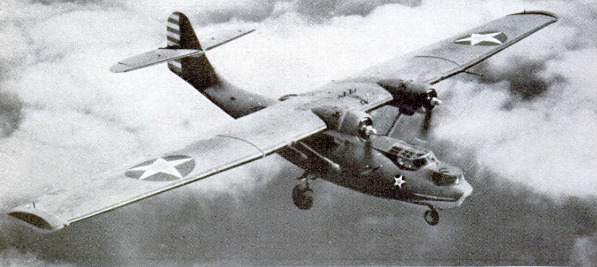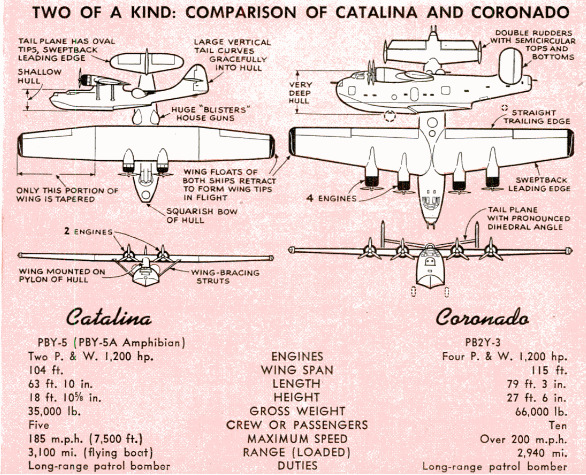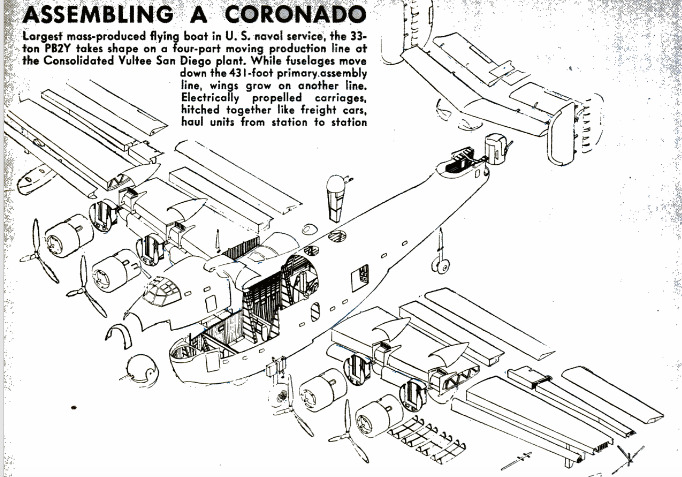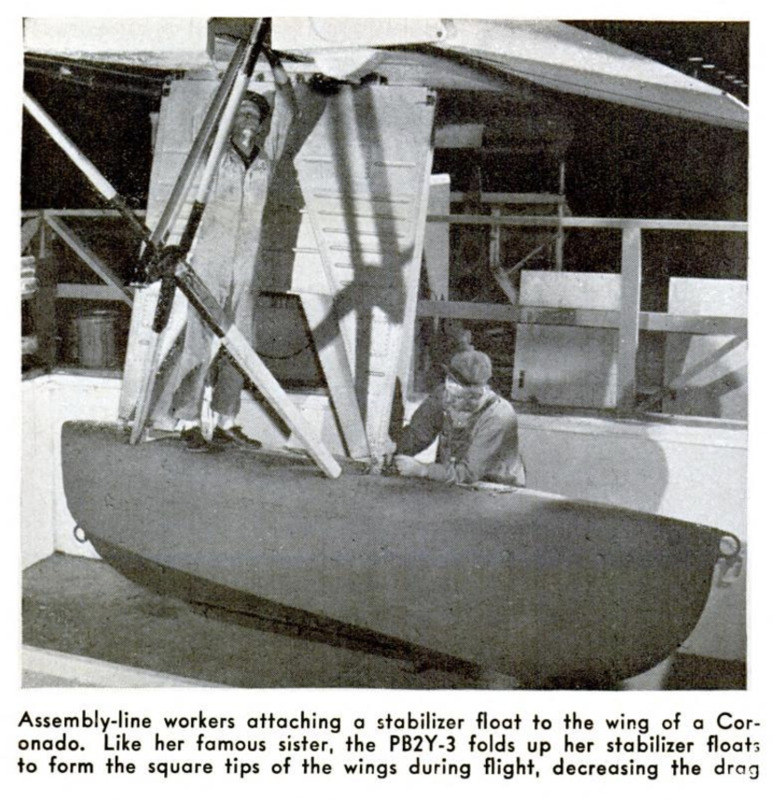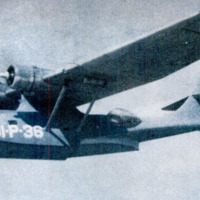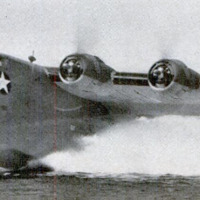-
Title (Dublin Core)
-
"Ghost Planes" Fights On
-
Article Title and/or Image Caption (Dublin Core)
-
"Ghost Planes" Fights On
-
extracted text (Extract Text)
-
THE normal life expectancy of an air-
plane design is about four years. Under
normal military operation, a fighting plane
is superseded by types that can outperform
it, as design science strides past yesterday's
milestones. New engines, better propellers,
improved wing sections, and superior ma-
terials make yesterday's winged miracle to-
morrow’s crate. Even in commercial air-
transport design, a four-year-old airplane
type is about ready for the freight runs in
the backwoods.
There is one holdout in airplane design: a
Navy-type flying boat that has managed to
survive a full decade and is now ready to
be reordered—the Consolidated PBY-5, the
tough, indestructible Catalina. The latest
dope on the “Cat” comes in an unobtrusive
release from the financial department of
Brewster Aeronautical Corp. Some weeks
ago, this company’s Newark division, which
had been engaged in building wings and tip
floats for the Cat, completed
what was believed to be the
last order for Navy PBY
boats. A new, slick twin-
engined ship with a deep
hull and a swift, high-
aspect-ratio wing was going to take its
place. The old Cat was, at last, going to die.
The idea evoked sighs of mingled nos-
talgia and relief in certain Navy flying
circles. The Cat was a slow, ungainly fly-
ing boat with apparently little to recom-
mend it in a modern war. Before the Sude-
ten occupation, the Navy had released it for
commercial purchase, and even allowed
Consolidated to sell license rights to Soviet
Russia. Now, for all practical purposes, the
Cat was to be allowed to die. Then, with
dramatic suddenness, Brewster announced
that a new contract for Catalina wings and
tip floats had been signed. The Cat had a
new lease on life.
The Catalina’s record in this war is a
glorious one. It began with another re-
prieve, this one by the British. The R.A.F.’s
Coastal Patrol needed a good production-type
flying boat, and needed it quickly. Consoli-
dated Aircraft had a splendid flying boat in
the prototype stage, with primary tooling
already under way. The British, however,
needed immediate deliveries on seaplanes—
needed them desperately, to patrol the sea-
ways around the embattled island. They
decided to forego the airplane of tomorrow
for one they could fly immediately, so the
Cat, which was scheduled for the limbo of
Jennies and Liberty DH's, was put back into
production as a stopgap. She has been fill-
ing the gap ever since.
Despite her lack of speed,
the Cat is among the best
seaboats ever built. Her
hull can stay in the water
for weeks on end, requiring
only cursory service. She waddles through
heavy weather, ever prowling in search of
German and Japanese warcraft. One found
the German battleship Bismarck and hung
on grimly, riddled by gunfire but not
downed, until British forces could be dis-
patched to destroy the Nazi battleship.
Others have torpedoed Japanese war ves-
sels, bombed Kiska hundreds of times, and
helped hold the Nazi submarine menace in
check from bases in Great Britain.
Now, confounding enemy and American
airmen alike, the Cat engages in dive-
bombing sorties, screaming down at the
unheard-of speed of 250 knots. Pilots drop
bombs by the “seaman’s eye” method, then
apply the strength of four arms to pull her
out into level flight.
Resting on the beach or in the water, the
Catalina, known by the Navy as the PBY-5
(flying-boat version) ‘and the PBY-5A (am-
phibian) reminds you of those other prewar
oats which have been outmoded by the
sleek craft of 1943. Unlike those other
relics of the past, she can fly over enemy-
infested waters for a total distance of 2,520
miles, starting with 1,463 gallons of gas in
her tanks and loaded with bombs or tor-
pedoes and ammunition for her 50 caliber
guns.
But she can’t reach enemy targets and
escape the withering fire of Zeros and
Heinkels with the sureness of a much faster
and more modern land
bomber. In fact, she
can’t escape at all, ex-
cept by hiding in the
clouds and mist. Her
gunners must man their
weapons and try to out-
shoot enemy attackers,
for a top speed of 185
m.p.h. gives them no
other choice.
Yes, the Cat must
fight to survive. And
somehow, miraculously,
as a breed she continues
to live, snooping through
the Aleutians’ perpetual
mists, night-hawking
over the Southern Pa-
cific to smell out Jap
concentrations, blasting
subs in the Mediter-
ranean and Atlantic, and
bringing back alive many
Yankee pilots, who, shot
into the sea, would oth-
erwise perish.
There were few Cats
in the Aleutians when
the battle for their oc-
cupancy began early in
June, 1942. Losses were heavy as the Navy
brought in more PBY's and threw their
crews into the fight to protect Alaska.
Many winged westward into the murk and
never came back. But their crews per-
formed miracles of bravery. On June 10, a
Cat found the first Japanese ships in Kiska
Harbor. The very next day, another, poking
its blunt snout through snow and rain, re-
ported Japanese landings at Attu.
How many Cats were lost in the Aleu-
tians may not be known for many months,
but the crews never wavered. Pilots of Pa-
trol Wing 4, shortly after Dutch Harbor
was first attacked, began bombing Kiska
as regularly as a clock ticks. For three
days they pasted Kiska through rains of
antiaircraft fire, destroying 65,000 tons of
shipping. One pilot beached his Cat after
reporting briefly, “Ship now land plane.
Hull no longer waterproof.”
The Navy's high command looks upon
these outmoded crates as offensive weapons,
no matter what their limitations. Pilots
and crews know that their very slowness
makes them excellent targets for both anti-
aircraft fire and enemy aerial gunfire. One
fiyer in the South Pacific radioed his com-
mander, “Am shadowing (the enemy).
Notify next of kin.” Ten minutes later he
was dead.
Shortly before dawn on June 3, 1942, En-
sign Jewell Reid, of Paducah, Ky., left Mid-
way on a routine patrol. By midmorning,
his Cat had covered several hundred miles
in a westerly direction, when he sighted on
the horizon several objects he did not im-
mediately identify. Reid swung the ship
about, moved in for a look-see, identified
them as a Jap fleet, reversed his course to
check their direction and speed. Then his
voice spoke into the radio, warning of the
intended attack on Midway. That night a
squadron of other Cats commanded by
Lieut. Gaylord D. Propst, partly protected
by darkness, launched torpedo attacks
against Japanese transports—the first time
these boats ever had been employed as tor-
pedo planes.
I. M. Laddon, vice president of Consoli-
dated Vultee Aircraft Corporation, scarcely
dreamed that these long-range boats would
play major roles in war when he designed
the first of the long line in 1933. He wove
into their metal and fabric qualities of long
range, durability, and comfort, plus capac-
ity for bomb-carrying. Two 800-horsepow-
er engines powered the first boat. Today's
Cats duplicate the prototype, with the ex-
ception of three major changes. A pair of
1,200-horsepower Pratt and Whitneys fitted
with hydromatic propellers haul them sky-
ward now, and two blisters on the sides of
the fuselage give the gunners a chance to
protect themselves against enemy gunfire.
Laddon built well. In 1937 the Navy, of-
ficially recognizing the worth of patrol
planes for scouting purposes, transferred all
scouting-force destroyers to the battle force,
and all patrol-plane squadrons to the scout-
ing force.
Ten years is a mighty long time in the
life of a plane, and while the Cats promise
to give added years of service, their “big
sister,” the 33-fon Coronado long-range pa-
trol boat, is now in production. These com-
bination aerial battleships and cargo-per-
sonnel carriers take shape on a four-part
moving production line, making them the
largest mass-produced flying boats now in
the U. S. naval service.
Known in the combat version as the
PB2Y-8 and the cargo carrier as PB2Y-3R,
the Coronado can fly long distances on pa-
trol or to carry needed goods to distant
battle areas. Under and in the wings of the
PB2Y-3 may be tucked several bombs andtorpedoes, or a six to eight-ton bomb load.
Up to 5,000 pounds of cargo may be carried
long distances with a heavy gasoline load.
The Coronado is a complex mechanism.
Her crew of ten, living and working in
seven main compartments on three decks,
operate 50 caliber machine guns mounted
in turrets placed in the nose, tail, and amid-
ships; drop their loads of bombs and tor-
pedoes, and prepare their reports while over
the sea. To facilitate take-offs and increase
her speed during flight, the hull has two
steps and a semicircular top, and the all-
metal after step terminates in a vertical
knife edge, which aids the boat in breaking
away from the water and holds it on course
before take-off. As on the Cat, stabilizing
floats retract during flight to form the
square-tipped wings. Twin fins and rudders,
large and set high, and a stub nose make
the boat easily recognizable. The wing
sweeps backward along the leading edge
and carries a ruler-straight trailing edge.
You haven't heard much about these big
boats, because they have been assigned pri-
marily to look and listen and carry big
loads without being trapped by the enemy.
Their names will appear more frequently
in the future, though, for new jobs are con-
stantly being found for the big sisters.
Right now the Navy Department is expand-
ing its Naval Air Transport Service from
three to 10 squadrons. Seven already have
been commissioned. This means more Coro-
nados will join the network which last year
covered. 50,000 miles of routes. A recent
$40,000,000 Congressional appropriation
promises the network will be tripled, with
personnel and cargoes destined for battle
being transported all over the world, from
Australia to Africa, from Iceland to Rio.
Recently another sister boat was an-
nounced. This is the Model 31, to be known
as the P4Y—a twin-engine, long range pa-
trol boat which the Navy considers the fast-
est flying boat ever built in America. Fitted
with the famed Davis wing, which helps
give the B-24 Liberator greater speed and
lift than most bombers her size, the newest
of the Cat family has been designed for
both combat and patrol duty. Carrying a
crew of seven, she is powered by two 2,000-
horsepower engines, measures 74 feet long,
stands 25 feet high, and weighs some
50,000 pounds. When she arrives, the Cats
will take a new lease on life.
-
Contributor (Dublin Core)
-
Andrew R. Boone (writer)
-
Language (Dublin Core)
-
eng
-
Date Issued (Dublin Core)
-
1943-10
-
pages (Bibliographic Ontology)
-
120-124
-
Rights (Dublin Core)
-
Public Domain (Google digitized)
-
Archived by (Dublin Core)
-
Matteo Ridolfi
-
Alberto Bordignon (Supervisor)
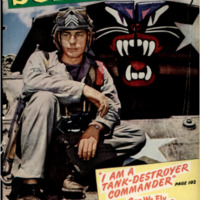 Popular Science Monthly, v. 143, n. 4, 1943
Popular Science Monthly, v. 143, n. 4, 1943

